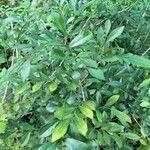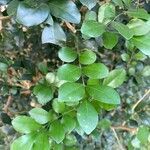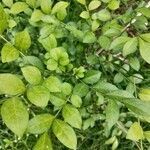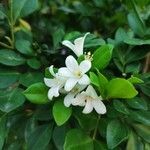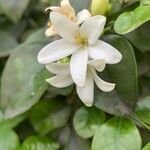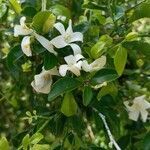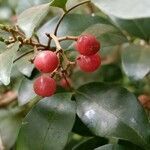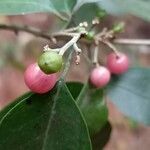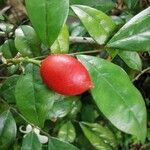Evergreen tree to c. 7 (–20) m high, but often a shrub. Bark smooth, pale to whitish. Young shoots glabrous to puberulous or distinctly hairy. Leaves imparipinnate, to 7 (–9)-foliolate, rarely trifoliolate, to 17 cm long, glossy, usually glabrous; leaflets cuneate-obovate, ovate, elliptic or almost rhomboid, (0.6–) 2.5–10 cm long, (0.5–) 1.2–5 cm wide, sometimes reflexed marginally, acute to acuminate, coriaceous, ± glabrous; petiolule 2–6 mm long. Flowers fragrant, in terminal and/or lateral corymbose thyrses; pedicels (0.3–) 1–1.3 cm long. Calyx lobes (4) 5, narrowly deltoid, c. 1 mm long, sparsely pubescent. Petals (4) 5, narrowly obovate, (8–) 13–18 (–25) mm long, white or cream, recurved at anthesis. Ovary 2-locular; stylehead glandular. Berries ovoid, c. 10–14 mm long, often apically pointed, glabrous, orange-red; seeds densely hairy.
Shrubs or trees, 1.8-12 m tall. Older branchlets grayish white to pale yellowish gray. Leaves 2-5-foliolate; petiolules less than 1 cm; leaflet blades mostly suborbicular to ovate to elliptic, 2-9 × 1.5-6 cm, margin entire or crenulate, apex rounded to acuminate. Inflorescences terminal or terminal and axillary. Flowers 5-merous, fragrant. Sepals ovate to lanceolate, to 2 mm, persistent in fruit. Petals white, narrowly elliptic to oblanceolate, to 2 cm. Stamens 10. Fruit orange to vermilion, narrowly ellipsoid or rarely ovoid, 1-2 × 0.5-1.4 cm. Seeds villous. Fl. Apr-Oct, fr. Apr-Feb. 2n = 18.
A shrub or small evergreen tree. It grows to 5 m high and spreads to 3 m across. The branches are grey and slender. The leaves are alternate and scattered. The leaves are compound with 2-8 leaflets. Leaves are 8 to 15 cm long and smooth. The leaflets are in pairs or alternately and are oblong and tapering bluntly. The flowers are white and few. They are star-shaped or bell shaped and with a sweet smell. The fruit are oval, fleshy and orange or red. They are 1.25 cm long and normally contain 2 seeds.
Evergreen shrub or small tree 1.5–3.5(–7) m.. Leaves as M. koenigii but leaflets 3–8 and glabrous.. Flowers in terminal and axillary corymbs, 5-merous; petals 11–27 mm. long, white; stamens mostly 10; ovary 2-carpellate.. Berries ± 7 mm. in diameter, red.
